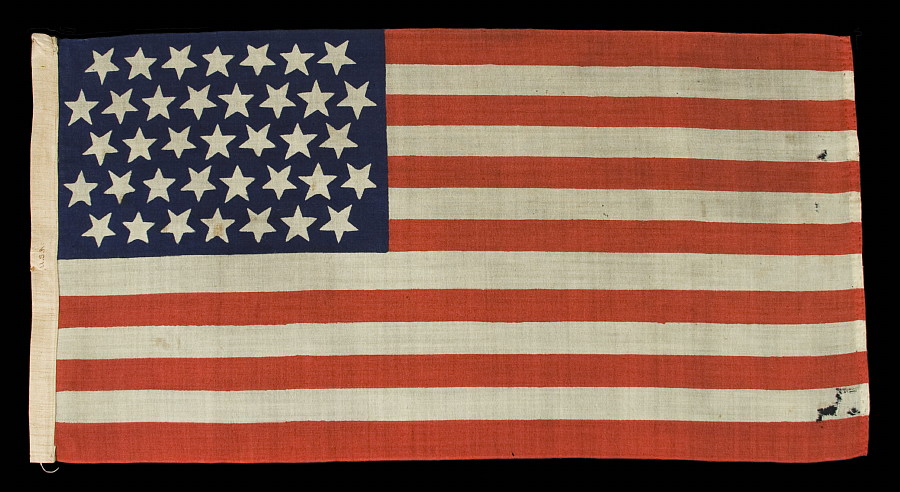
| |
37 STARS WITH A "DANCING" OR "TUMBLING" FORMATION OF LINEAL ROWS, ON A FLAG WITH AN ELONGATED PROFILE, PROBABLY MADE BY THE U.S. BUNTING COMPANY IN LOWELL, MASSASCHUSETTS, 1867-1876, NEBRASKA STATEHOOD |
|
| Available: |
Sold |
| Frame Size (H x L): |
|
| Flag Size (H x L): |
18.75" x 36" |
|
| Description....: |
|
37 STARS IN A "DANCING" OR "TUMBLING" FORMATION OF LINEAL ROWS, ON A FLAG WITH AN ELONGATED PROFILE, PROBABLY MADE BY THE U.S. BUNTING COMPANY IN LOWELL, MASSASCHUSETTS, 1867-1876, NEBRASKA STATEHOOD:
37 star American National flag, press-dyed on wool bunting, probably made by the U.S. Bunting Company in Lowell, Massachusetts. The stars are arranged in linear fashion, but are consecutively oriented point-up, point down to create what I call a "tumbling" or "dancing" formation. Note how the profile of the flag is slightly elongated. Together these two features add a nice degree of folk quality to the overall design.
The 37th state, Nebraska, joined the Union in 1867, shortly following Lincoln's death and the close of the Civil War. It was the primary flag flown during Reconstruction of the South and was used through approximately half the Indian Wars period, but the lack of major patriotic events during this era and the surplus of Civil War period flags led to much lower production. For this reason, 37 star flags are quite scarce compared with the Civil War period flags that preceded them and the flags made for the 1876 centennial.
Despite the fact that the 37 star flag remained official until 1877, flag-makers generally produced 38 star flags for the 100-year anniversary of our nation's independence, along with 13 star flags to commemorate the original colonies. By 1876 it was well known that at least one new state, Colorado, would soon join the Union. That circumstance caused flag-makers to cease production of flags with 37 stars in favor of 38. It had been nine years since a new star was added, so flag-makers were anxious to add a star and give the American people a reason to buy new flags. Some produced 39 star flags in anticipation that two new states would soon join the Union instead of just one. Both these and the 38 star flags made during that year were unofficial, of course, but there were no flag police, so speculation led the way to new flags with the hope to increase sales.
The press-dyeing process was patented in 1849 as a method of printing flags on wool. It was primarily used during the 1876 centennial era by the U.S. Bunting Company, which began making press-dyed flags for the U.S. military in 1869. This was one of the first firms to successfully produce high quality wool bunting fabric in the United States, and while its owners worked diligently to master the press-dyeing process, it was apparently more costly than one might presume, because it never caught on in America as a popular means of flag production.
Also called resist-dyeing, to achieve white stars, for example, pieces of waxed fabric or paper in the shape of stars had to be cut out and carefully placed on both sides of the white wool bunting. The fabric was then dyed blue and the areas where the silhouettes were placed would not absorb the dye and thus be left white. The same process was repeated to make the red stripes. This inexact art would often add crude characteristics, such as stripes with irregular lines and in various widths, and stars with inconsistent shapes, in slightly varying sizes. It is likely that this resulted in lost product and wasted time, from flags that had bleeding or misprint issues and were of too poor quality to sell. But within those flags that survived, today's collectors today find the irregularities interesting, not only because they demonstrate early production methods, but also because they lends the sort of folk qualities that make early flags more interesting to look at. That is certainly the case here, particularly with regard to the wide variation in the profiles of each star across the blue field.
There is a heavy cotton sleeve along the hoist which was affixed with treadle stitching and the fly end has been bound by hand. The letters "U.S.A". were written along the hoist with a dip pen, probably around the time of the flag's making. It may be that the flag was flown with a series of international flags and was labeled for ease in identification, or it may have been used aboard a foreign ship that sailed into U.S. ports.
Mounting: The flag has not yet been mounted.
Condition: There is very minor mothing throughout, accompanied by an area with moderate mothing near the fly end of the last white stripe. This can easily be dealt with during the mounting process, if desired. There is very minor foxing and staining. Many of my clients prefer early flags to show their age and history of use. |
|
|
|
| Collector Level: |
Beginners and Holiday Gift Giving |
|
| Flag Type: |
|
|
| Star Count: |
37 |
|
| Earliest Date of Origin: |
1867 |
|
| Latest Date of Origin: |
1876 |
|
| State/Affiliation: |
Nebraska |
|
| War Association: |
1866-1890 Indian Wars |
|
| Price: |
SOLD |
|
| |
Views: 3137 |
|
|
|

